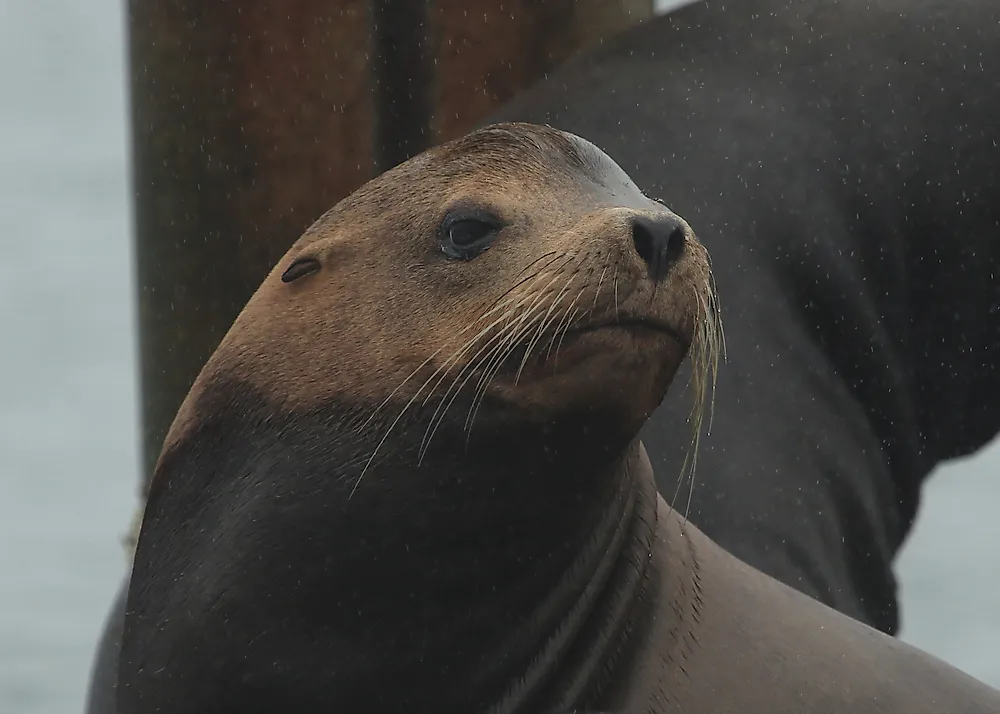California Sea Lion Facts: Animals of North America

5. Physical Description
California sea lions (Zalophus californianus) are a species of "coastal eared seals". They exhibit sexual dimorphism, wherein adult males usually have body sizes that are 1.2 times longer, and weights that are 3-4 times higher, than those of the females.They have an average size ranging between 5.5 and 7.25 feet (1.7 and 2.2 meters) and average weights ranging between 610 to 860 pounds (275 to 390 kilograms). The coat color of these animals varies between chocolate brown in males to golden brown in females. Males develop a sagittal crest at the age of about 5 years, which initially appears as a bump upon their heads. The streamlined body and well-formed flippers of these sea lions allow them to adapt well to their aquatic habitats. Thick layers of blubber insulate their bodies against the cold waters of the Pacific Ocean.
4. Diet
The California sea lion has an extremely flexible diet with a large prey base. This varies as they change their location. Usually, they feed on four to five species that are locally abundant in, and specific to, any given region. Fish, squids, and clams are all parts of the diets of these sea lions throughout much of their range. Pacific Sardines, Jack Mackerels, Red Octopuses, and Northern Anchovies are some of the species most commonly consumed by these animals in the California region. The primary prey base of the sea lions in the Sea of Cortez along the Mexican shore includes the Plainfin Midshipman, the Deepwater Serrano, the Pacific Cutlassfish, and other local marine species. They usually forage along the coastlines and the waters above the continental shelf zone, as well as venturing further towards the bottom of the ocean, though less frequently.
3. Habitat and Range
The California sea lions inhabit the waters of the Pacific Ocean ocean over the continental shelf and slope zones. They are often spotted in river mouths, bays, and the sandy or rocky shores of harbor areas. California sea lions thrive along the western coastline of North America, and have been spotted as far north as the Gulf of Alaska to as far south as Punta San Pedrillo, Costa Rica. Rookeries (breeding colonies) of these animals can be observed from the islands located in Baja California Sur (Mexico) to those further north in southern California (U.S.). This species has been classified under the ‘Least Concern’ category by IUCN, due to their widespread and growing population size. Nonetheless, irresponsible fishing practices, poaching, and natural disasters, including El Niño-related weather events, account for significant contributions to the mortality rates of these sea lions. Killer whales and large sharks are the natural predators of this species.
2. Behavior
California sea lions are highly intelligent and playful. They can remain at sea for about 14 days in a single stretch, during which time they migrate or forage, either alone or in groups. Such sea trips are usually followed by ‘haul-out’ phases, when the sea lions rest themselves at specific locations along the shore. After the breeding season, adolescent and adult male sea lions usually migrate northwards, some reaching as far north as Oregon or even British Columbia. The females, however, will continue to forage in the waters closer to the rookeries. Females and juveniles undergo molting during fall and winter, while males usually molt during the months of January and February. The California sea lions have for long been the object of important scientific research due to their high cognitive abilities. The animals have been popularly used by circuses and marine mammal parks for entertainment purposes due to their abilities to quickly learn performance tricks. Animal welfare organizations, however, continue to criticize the use of these animals for such purposes.
1. Reproduction
The California Sea Lions attain sexual maturity at about 4 to 5 years of age. Breeding takes place during the summer months of May to July. Males strictly defend their territories, often even fasting (abstaining from food) to maintain their positions within their respective rookeries. During this time, they depend on their blubber as a stored energy source. Females choose their mates by moving from one male-occupied territory to another within a rookery. With a gestation period of 11 months and only a single pup produced by a female in a year, the growth rate of these animals is quite slow. The newborn pups are tended by their mothers for a period of about 10 days, after which time the females start moving back into the waters for foraging purpose. They sometimes forage for as long as 3 days, while the pups remain on shore and play or socialize amongst themselves. The females return again to nurse their pups for short intervals, generally lasting no longer than a day. The mother and pup communication is distinct for each pair and, after a certain stage, the pups start entering the waters with their mother to develop their own foraging skills. Adult male sea lions have little role to play in raising the pups, but show a relatively higher level of involvement than males of other otariid (Eared seal) species.











